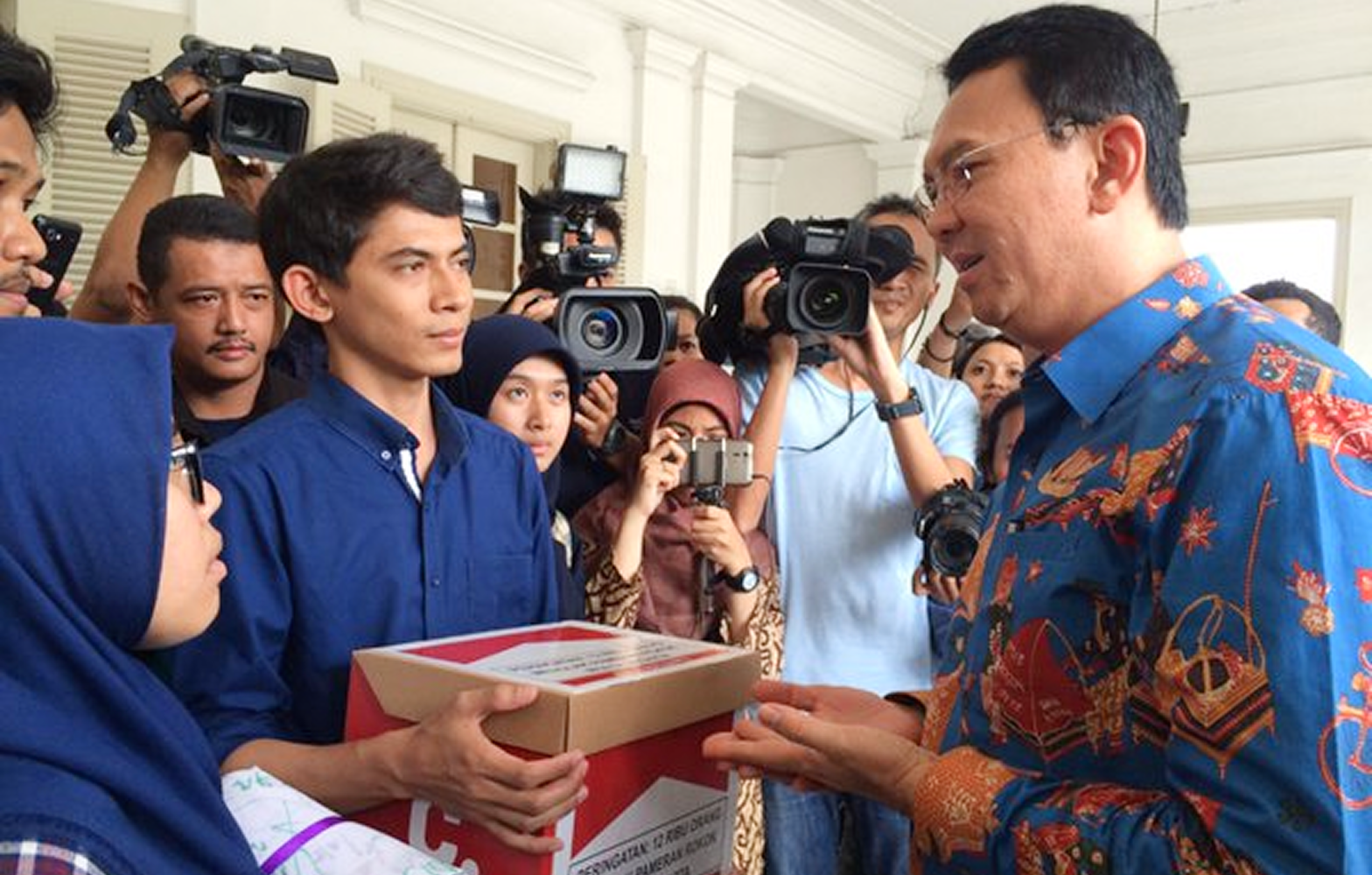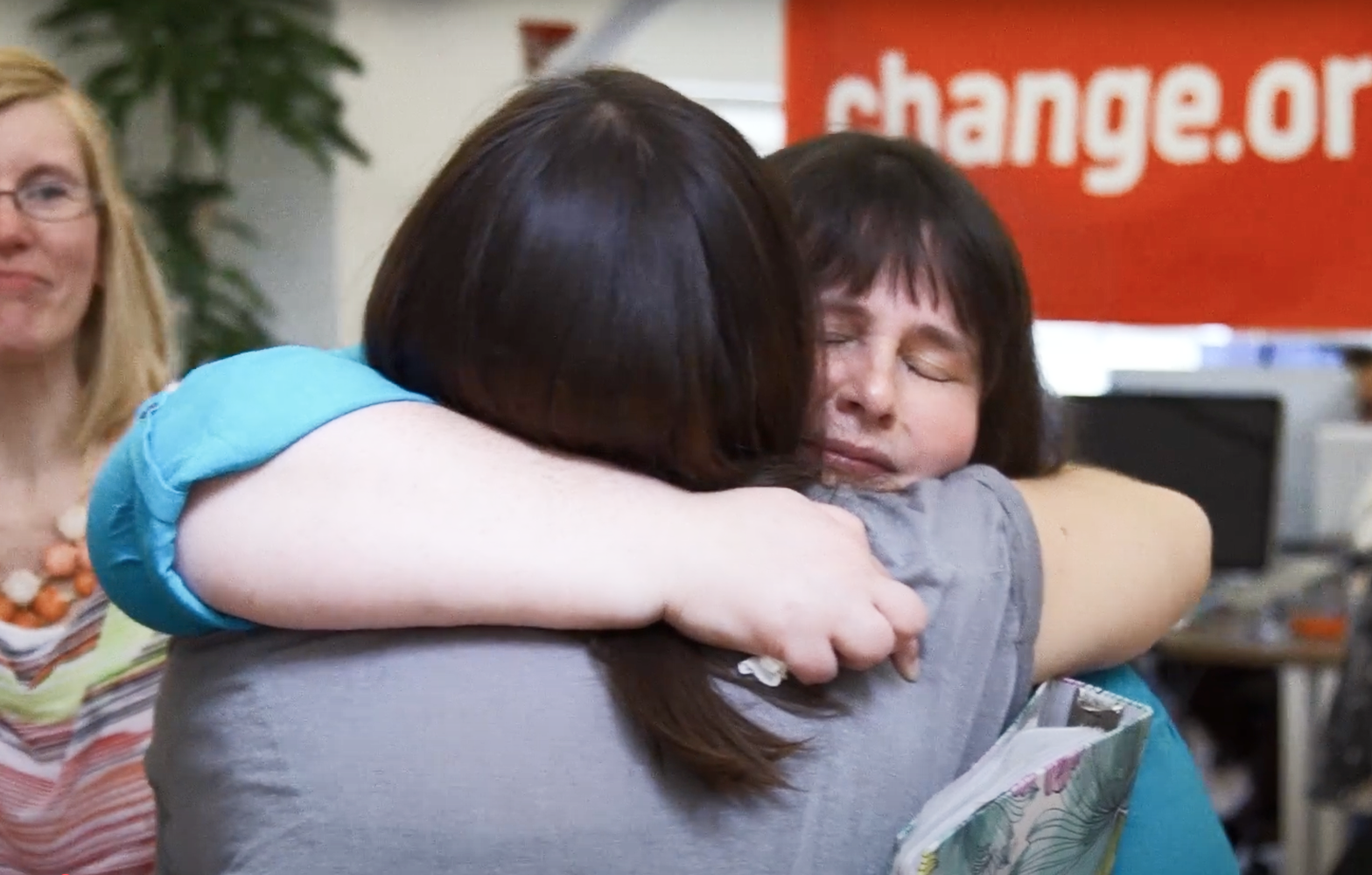In this article you will learn:
After a tragic crash killed five teens on a dangerous road in Fort Myers, Florida, a local resident started a Change.org petition calling for new safety measures. The petition was specific, locally focused, had a powerful personal example at the center, and directed at the right decision makers. It gained over 41,000 signatures and public outcry reached beyond the petition page to media coverage and local meetings where local residents spoke.
Within weeks, city and state officials responded — agreeing to install new signage and safety features. This outcome shows what’s possible when you combine clear demands, local relevance, and strategic outreach. In this guide, we’ll walk you through how to do the same to get results from the people in power.
Step 1: Identify the key decision maker
Once you have support behind your cause, it's time to move forward and connect with the people in power who can help — the key decision maker(s). Follow these steps to plan how to get your foot in the door with the people who have the power to implement change.
Pinpoint who holds the power. Is it a local official, a department head, or someone in a private organization? Sometimes it's one person, other times it’s several. Make a list of people who could take action.
Understand the structure. Research how the relevant organization operates. For example, if your target is a city council, find out which member oversees the issue at hand. If you’re aiming for a state representative, look up their legislative staff.
Build relationships with gatekeepers. These are the assistants, associates, or staffers who manage access to decision makers. Reaching out to them first can help you get your message through — and they may even become champions of your cause.
Focus on specific, local decision makers. Go for the most immediate person who can take action. Local officials are often more responsive than high-level executives or state leaders. If your issue is about school policies, start with the principal of one school or an individual school board member, not the state education department. Once you have them on board, you can make change at a local level and then pursue it on a larger scale.
Ask for suggestions. If you’re not sure where to start when finding the right decision maker, ask people aligned with the issue for help. For example, a concerned mother fought the Medicaid restrictions for a type of therapy that helps children with autism. By asking her son’s therapy center and other parents for ideas of contacts, she was able to find the right people and won her battle for expanded coverage.
💡 Read the full guide to how to get a law changed
Engaging with decision makers: Dos and don'ts
Once you’ve identified the right decision maker — someone who has the power and position to act — your next move is to get their attention in a way that compels action. Based on what we’ve seen succeed at Change.org and direct feedback from decision makers in a national survey, there are clear strategies that work — and common pitfalls that don’t. Follow these tips to help your petition break through and inspire results.
✅ Do: Target specific issues and demands
Broad asks like “fix education” or “protect the environment” are important, but they’re hard to act on. The most successful Change.org petitions focus on clear, narrow demands that decision makers can realistically address.
Petition starter Siddhu Pachipala put it best:
“‘When we have big issues like ‘we need to fix education here in Texas’ — if we slice big issues into little ones — like focusing on a specific book being banned at one school at one time — it’s much easier for people to act.”
For example, instead of asking a school district to "improve school safety," focus your petition on installing crossing guards at a dangerous intersection outside your local school. Smaller, targeted demands are more winnable and actionable — and open the door to broader change later.
✅ Do: Research your decision maker
The more you know about your decision maker, the more effectively you can persuade them. Look into their:
Voting record (like, have they supported environmental protections or healthcare funding in the past?)
Public statements (like, do they speak frequently about equity, youth development, or fiscal responsibility?)
Personal background (like, are they a former educator, a veteran, or a parent?)
Example: Let’s say your petition is about banning single-use plastics and your city councilmember has previously introduced legislation on climate change. Highlight how your ask aligns with their prior commitments. If a school board member frequently talks about student wellbeing, emphasize how your proposal would make students feel safer or more supported.
According to our survey, 40% of decision makers said they were more likely to respond when a petition aligned with their personal or political values.
✅ Do: Plan your method of contact
Think about how you’ll reach your decision maker. Surveyed decision makers said the most effective outreach methods include, in descending order:
Personal emails
In-person meetings or office visits
Phone calls
Speaking at town halls
Tagging on social media, especially on local platforms
Government agencies and corporations can be bureaucratic, so don’t stop at the “contact us” form on the website. Keep digging until you find the name and contact info for the specific person with the power to act — or their assistant. That’s who you want to connect with directly.
✅ Do: Emphasize local impact and community relevance
Decision makers are most responsive when they know an issue affects their constituents. Use your petition to show how the outcome will benefit the local community — not just a small group of individuals.
Survey respondents said they were more likely to act when:
Signers are registered voters or constituents
The issue supports the goals of the city or serves the common good
The decision would improve conditions for the majority
Example: If you’re petitioning to open a public cooling center during extreme heat waves, frame it as an action that will protect vulnerable residents — including seniors, children, and people without air conditioning — across the neighborhood.
Use the Change.org petition dashboard to show how many people from your area have signed.
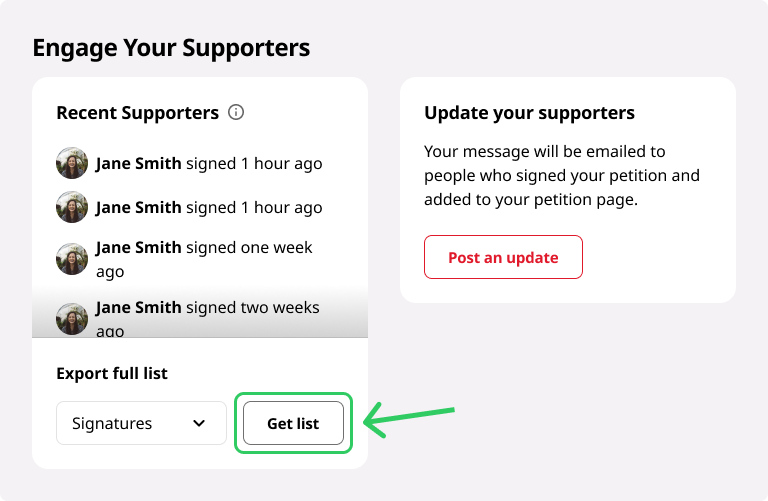
✅ Do: Highlight personal stories and supporting data
During the information gathering stage before you start your petition, log examples and stories you hear from people affected by the issue that you can bring up to decision makers. You can also source your supporters’ perspectives and personal experience that they leave as comments on your petition. You can even encourage them to leave their stories in the comments by asking them to in a petition update. The most persuasive stories are:
Personal: Real-life experiences from people directly affected by the issue
Local: Stories from constituents or people in the decision maker’s area
Factual: Combined with credible stats, relevant policies, or legal context
Respectful: Avoiding exaggeration, insults, or irrelevant information
✅ Do: Prepare for in-person meetings or public commentary
If you have a chance to sit down with a decision maker face to face in their office or virtually, make the most of that opportunity. A successful meeting starts with solid prep. Here’s how:
Practice your pitch with a friend and rehearse the key points: what your issue is about, why it’s important, what you’re asking to be done, and what that will achieve
Bring up the local impact — like how a policy change will reduce traffic near a school or improve access to services in an underserved area
Bring your petition materials: printed signatures, supporting letters or comments from the community, and key facts and data related to the issue
Agree on next steps. Write down actions you or the decision maker agrees to take and repeat them back at the end of the conversation. Agree on a timeline for all actions.
Know your non-negotiables. For example:
If your petition is about restoring library hours, you might insist on weekend access, but be open to compromise on weekday schedules.
If it’s about banning discriminatory dress codes, you might hold firm on the elimination of specific policies, but leave room for broader student input in rewriting them.
Be honest about what you’re willing to compromise on — and listen to what the decision maker has to say. Some may offer solutions you hadn’t considered.
✅ Do: Follow up
After your meeting:
Send a thank-you message and include a recap of what was discussed and any agreed-upon next steps
Update your supporters and tell them what you need next — such as emailing the official, making phone calls, or showing up at an upcoming vote
Reach out to the media about developments if appropriate, to help shape public narrative and increase awareness
Schedule regular check-ins to hold your decision maker accountable — whether it’s a polite follow-up email or a public reminder
Example: If your city councilmember promised to bring up your petition at the next meeting, send a reminder a few days before and then follow up to see if they did. Your supporters can help by sending thank-you notes or nudging the decision maker on social media.
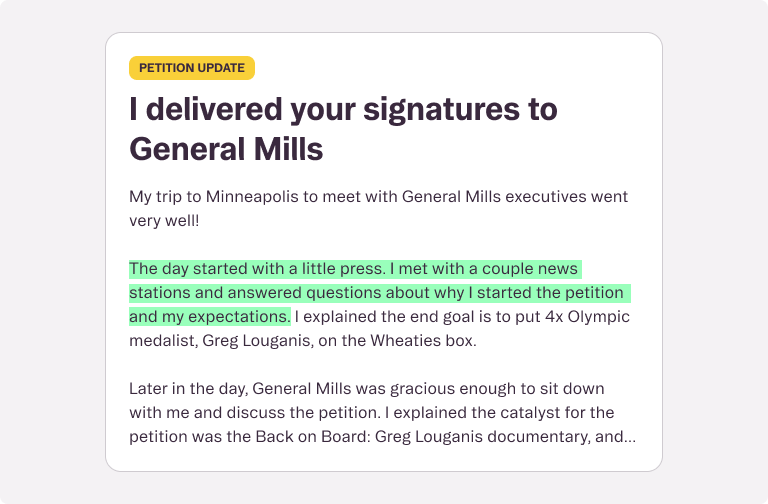
✅ Do: Mobilize supporters to participate
Let your supporters know when there are any opportunities to support direct actions, like when you’ve scheduled a meeting or are delivering your petition via email or in-person. Invite them to join mobilization efforts, like:
Attend the meeting
Show up to a rally or event
Tag the decision maker online
This creates public visibility, puts positive pressure on the decision maker, and shows them people are paying attention. When a petition is seen as part of a broader movement, it’s much harder to ignore. Here’s an example of how to use petition updates to encourage participation:
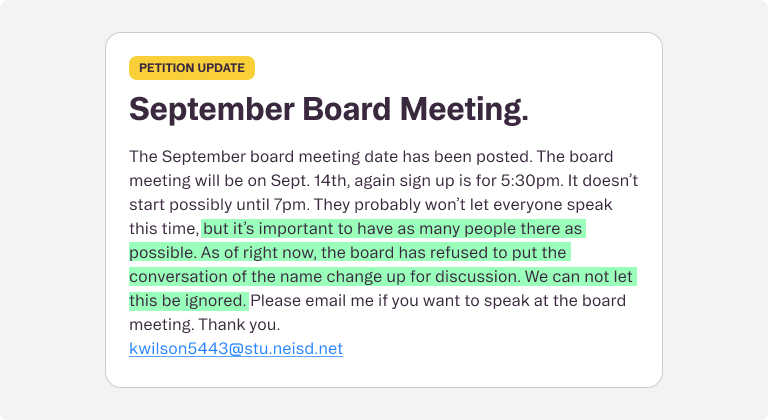
✅ Do: Learn from successful Change.org petitions
Draw inspiration from wins that show how local, specific petitions can spark real change. For example:
Petition to shut down a harmful chemical plant in Pennsylvania
In response to a community-led petition demanding accountability for a massive chemical spill in Bristol, Pennsylvania, local residents successfully pushed for action from government officials. The petition gained traction by emphasizing the immediate health threats and the responsible facility’s history of safety violations.
Community members described the chaos and fear caused by delayed public notification, water contamination risks, and a long pattern of environmental negligence by the company. Thanks to this public pressure, the Pennsylvania Department of Environmental Protection received an urgent letter from 10 elected officials calling for a thorough investigation, penalties, and stricter monitoring and inspection protocols at the facility.
Petition to open a child development center in California
In a powerful example of community-driven advocacy, Napa families mobilized to support a plan to open a new Child Development Center in the area. Facing opposition from a small group of neighbors, petitioners highlighted the region’s severe childcare shortage and the broad benefits the proposed facility would bring.
Supporters used several key mobilization tactics: they signed and widely shared a petition, sent emails to city officials, and showed up in person at a key Napa City Council meeting to voice their support. Their efforts paid off when the Council unanimously denied the appeal and upheld LPE’s Use Permit. This win demonstrated how organized public support can influence decision makers and lead to tangible, community-centered progress.
A breakdown of the oop reasons decision makers say they respond to petitions—ranked by the percentage who chose each as their #1 motivator.
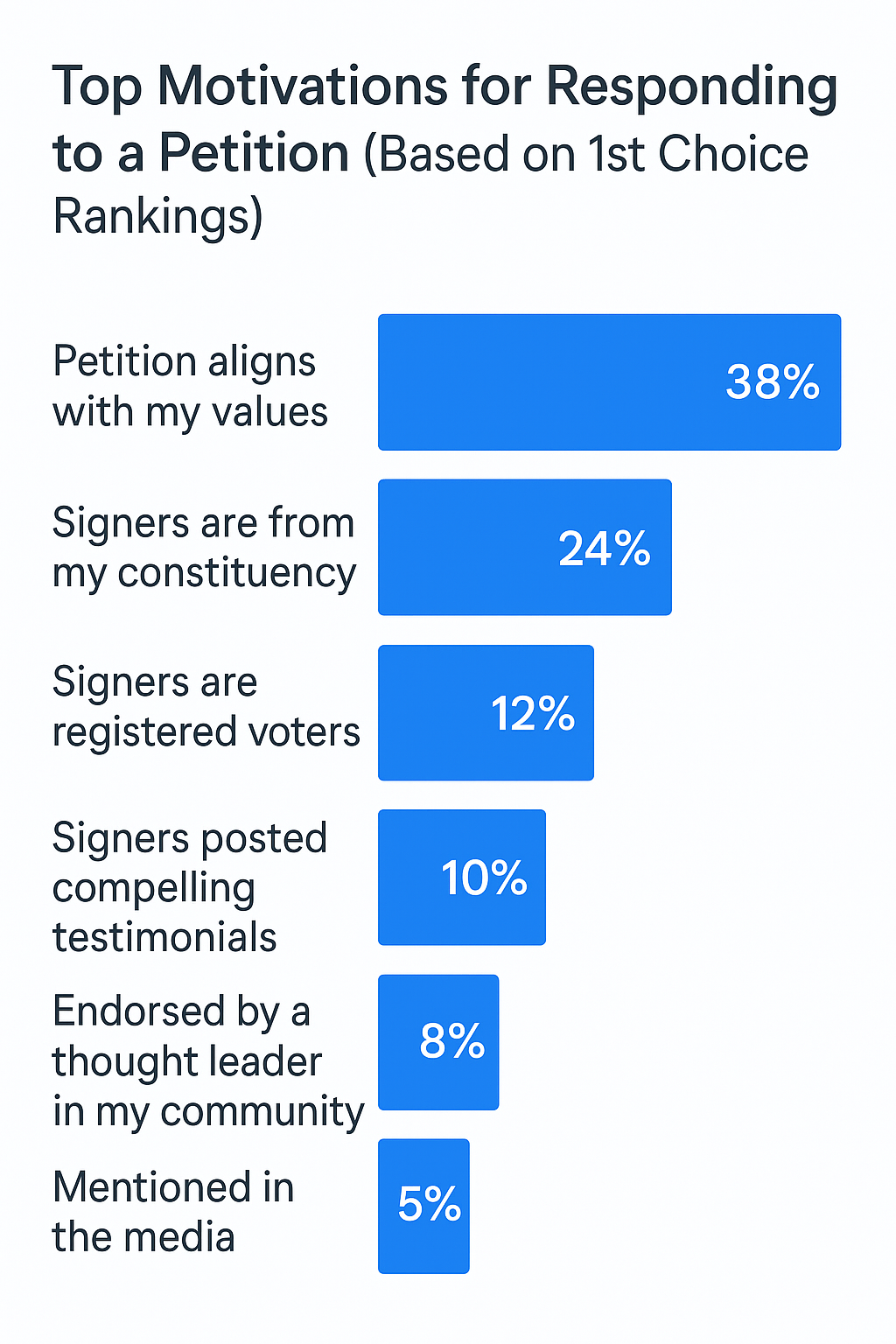
A breakdown of the top reasons decision makers say they respond to petitions—ranked by the percentage who chose each as their #1 motivator.
What Not to Do When Engaging Decision Makers
Avoid these common missteps — based on what real decision makers told us pushes them away:
❌ Aggresive tone and behavior
Anger, threats, or personal attacks make it hard for decision makers to take your request seriously — and may shut down communication altogether.
Avoid:
Insults or yelling (“You’re a disgrace!”)
Threats (“You’ll regret this at the polls!”)
Hostile language (“You’re the problem here!”)
Entitlement (“You work for me — do your job!”)
One official said: “The least persuasive message is one that’s rude and full of copied-and-pasted slogans.”
❌ Lack of relevance or misinformation
Make sure your petition is within the decision maker’s power to act on. Don’t send them irrelevant or legally impossible demands.
Avoid:
Asking a city councilmember to stop a federal policy
Referencing a bill without reading it — or misstating what it does
Assuming everyone who signs is a constituent (especially if they’re not)
Making accusations without context or facts
“Asking me to act on something I have no authority over is frustrating,” shared one elected official.
❌ Poor communication style
Not putting time and effort into your communication approach can make even a good petition easy to ignore.
Avoid:
Copy/paste or mass messages with no personalization
Messages without your name, address, or contact info
Overly simplistic solutions (“Just fix it!”)
Speaking without listening
“The absolute least persuasive communication I receive is a form mailing,” said one official.
❌ Extreme or inaccurate political and ideological framing
Highly partisan, ideological, or conspiratorial framing turns people off and makes your message easier to dismiss.
Avoid:
Pushing conspiracy theories or government distrust
Framing your cause in narrow political terms
Highlighting personal grievances (“I worked hard, so I deserve better”) over collective community good
❌ Poor timing or context
Even the most compelling message can be ignored if it reaches a decision maker at the wrong moment or without an understanding of the bigger picture. Effective advocacy requires strategic awareness of timing, jurisdiction, and current events.
Avoid:
Reaching out during a personal crisis or holiday. Avoid calling or showing up unannounced during evenings, weekends, or holidays. Check public schedules (like council meeting calendars or office hours) and send your message during business days.
Assuming facts without verification. If your petition is based on rumors or outdated information, it can backfire. One official told us: “People send angry messages based on something they saw in a Facebook group that isn’t even happening.” Always fact-check your claims using credible sources, and be open to learning new information.
Practical tips to avoid poor timing or context:
Look up your decision maker’s jurisdiction and current responsibilities before launching your campaign.
Align your outreach with key decision-making moments — like a vote, a budget planning session, or a public hearing.
Use local news alerts, government newsletters, or community calendars to time your contact strategically.
Be sensitive to the tone and urgency of current events. For example, avoid launching a non-emergency campaign during a natural disaster, public mourning, or major city crisis.
Thoughtful timing shows respect and increases the chance your message will be heard — and acted on.
Keep the momentum going
Engaging with decision makers isn’t just about making a demand — it’s about building relationships, shaping public conversations, and demonstrating the collective power behind your cause. Whether your petition results in a win, a delay, or a refusal, there’s always a next move you can make.
If your ask was met: declare victory, thank your decision maker, and express how your supporters helped make it happen. If you’re still waiting or hit a roadblock, don’t give up. Update your supporters, ask for their input, and keep the pressure on with tactics you haven’t tried yet.
Remember, change rarely happens overnight. What matters most is persistence, clarity, and community. Feeling ready to take the next step? Start your petition today — and use your voice to make change happen.
